2006 SUBARU IMPREZA airbag
[x] Cancel search: airbagPage 77 of 365
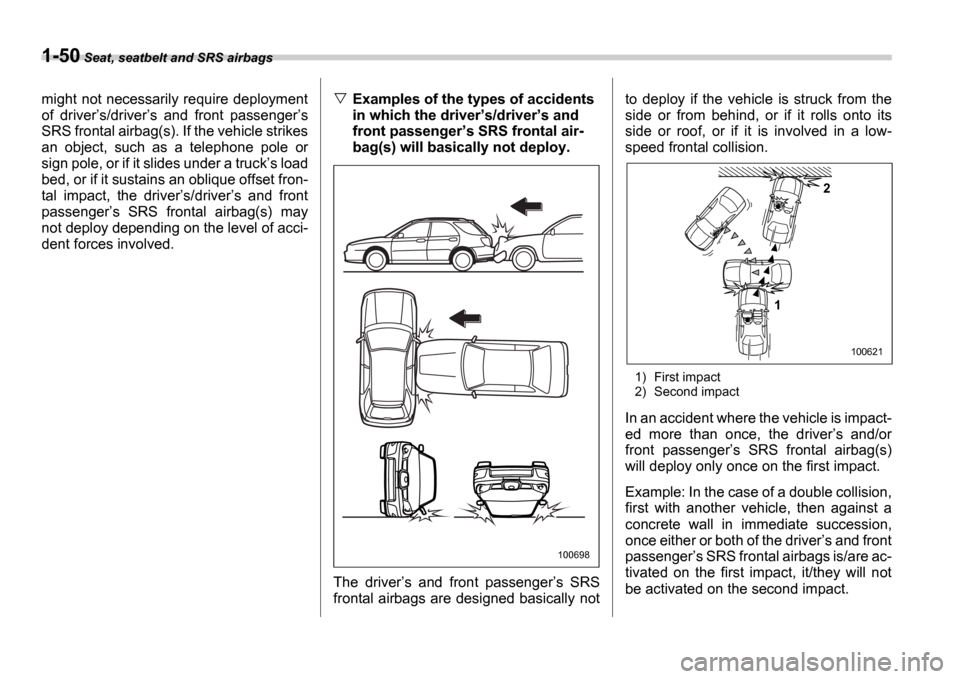
1-50 Seat, seatbelt and SRS airbags
might not necessarily require deployment
of driver s/driver s and front passenger s
SRS frontal airbag(s). If the vehicle strikes
an object, such as a telephone pole or
sign pole, or if it slides under a truck s load
bed, or if it sustains an oblique offset fron-
tal impact, the driver s/driver s and front
passenger s SRS frontal airbag(s) may
not deploy depending on the level of acci-
dent forces involved.Examples of the types of accidents
in which the driver s/driver s and
front passenger s SRS frontal air-
bag(s) will basically not deploy.
The driver s and front passenger s SRS
frontal airbags are designed basically not to deploy if the vehicle is struck from the
side or from behind, or if it rolls onto its
side or roof, or if it is involved in a low-
speed frontal collision.
1) First impact
2) Second impact
In an accident where the vehicle is impact-
ed more than once, the driver
s and/or
front passenger s SRS frontal airbag(s)
will deploy only once on the first impact.
Example: In the case of a double collision,
first with another vehicle, then against a
concrete wall in immediate succession,
once either or both of the driver s and front
passenger s SRS frontal airbags is/are ac-
tivated on the first impact, it/they will not
be activated on the second impact.
100698
2
1
100621
Page 78 of 365
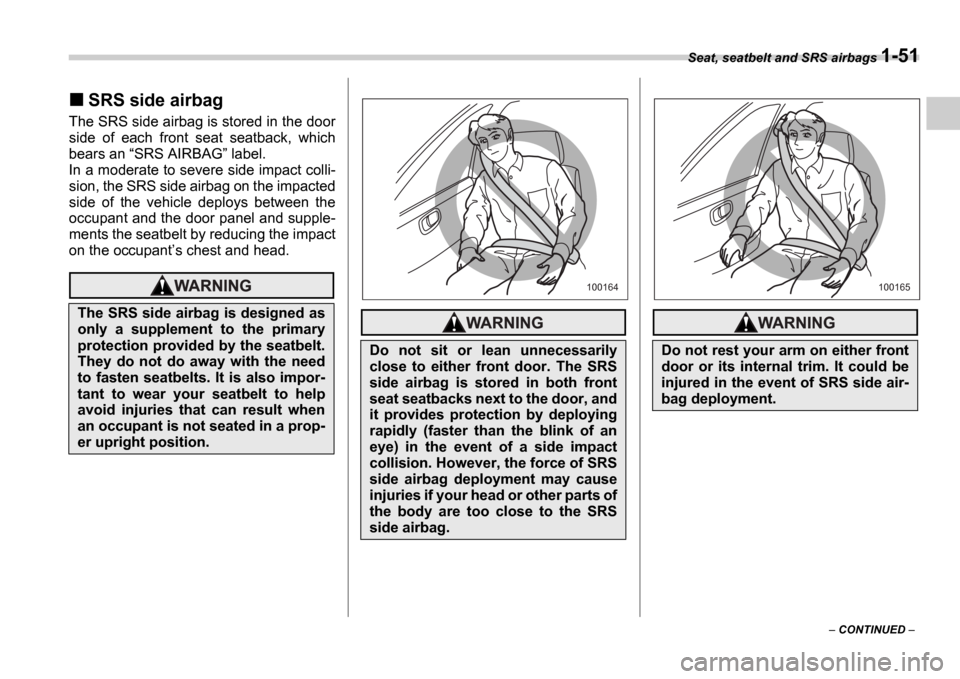
Seat, seatbelt and SRS airbags 1-51
CONTINUED
SRS side airbag
The SRS side airbag is stored in the door
side of each front seat seatback, which
bears an SRS AIRBAG label.
In a moderate to severe side impact colli-
sion, the SRS side airbag on the impacted
side of the vehicle deploys between the
occupant and the door panel and supple-
ments the seatbelt by reducing the impact
on the occupant s chest and head.
The SRS side airbag is designed as
only a supplement to the primary
protection provided by the seatbelt.
They do not do away with the need
to fasten seatbelts. It is also impor-
tant to wear your seatbelt to help
avoid injuries that can result when
an occupant is not seated in a prop-
er upright position.
Do not sit or lean unnecessarily
close to either front door. The SRS
side airbag is stored in both front
seat seatbacks next to the door, and
it provides protection by deploying
rapidly (faster than the blink of an
eye) in the event of a side impact
collision. However, the force of SRS
side airbag deployment may cause
injuries if your head or other parts of
the body are too close to the SRS
side airbag.
100164
Do not rest your arm on either front
door or its internal trim. It could be
injured in the event of SRS side air-
bag deployment.
100165
Page 79 of 365
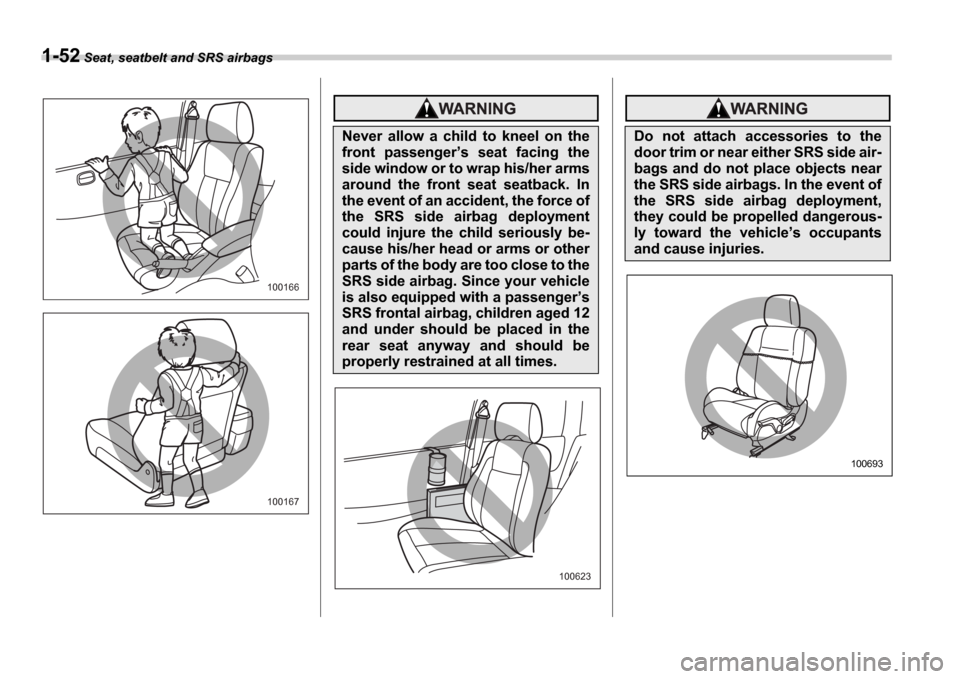
1-52 Seat, seatbelt and SRS airbags
100166
100167
Never allow a child to kneel on the
front passenger s seat facing the
side window or to wrap his/her arms
around the front seat seatback. In
the event of an accident, the force of
the SRS side airbag deployment
could injure the child seriously be-
cause his/her head or arms or other
parts of the body are too close to the
SRS side airbag. Since your vehicle
is also equipped with a passenger s
SRS frontal airbag, children aged 12
and under should be placed in the
rear seat anyway and should be
properly restrained at all times.
100623
Do not attach accessories to the
door trim or near either SRS side air-
bags and do not place objects near
the SRS side airbags. In the event of
the SRS side airbag deployment,
they could be propelled dangerous-
ly toward the vehicle s occupants
and cause injuries.
100693
Page 80 of 365

Seat, seatbelt and SRS airbags 1-53
CONTINUED
Operation
1) SRS side airbag deploys as soon as a
collision occurs.
2) SRS side airbag protects the front pas- senger s head and chest.
3) After deployment, SRS side airbag starts to deflate immediately.
The SRS side airbag can function only
when the ignition switch is in the ON po-
sition.
The driver s and front passenger s SRS
side airbags deploy independently of each
other since each has its own impact sen-
sor. Also, the SRS side airbag deploys in-
dependently of the frontal airbags in the
steering wheel and instrument panel.
An impact sensor is incorporated into
each of the vehicle s center pillars. If ei-
ther sensor detects a certain predeter-
mined amount of force during a side im-
pact collision, the control module sends a
signal to the side airbag module on the im-
pacted side of the vehicle, instructing it to
inflate the SRS side airbag. Then the side
airbag module produces gas, which in-
stantly inflates the SRS side airbag. After
deployment, the SRS side airbag will de-
flate in a few seconds.
The SRS side airbag deploys even when
no one occupies the seat on the side on
which an impact is applied.
When the SRS side airbag deploys, a sud-
den, fairly loud inflation noise will be heard
and some smoke will be released. These
occurrences are normal result of the de-
ployment. This smoke does not indicate a
fire in the vehicle.
Do not put any kind of cover or
clothes or other objects over either
front seatback and do not attach la-
bels or stickers to the front seat sur-
face on or near the SRS side airbag.
They could prevent proper deploy-
ment of the SRS side airbag, reduc-
ing protection available to the front
seat s occupant.
1 2 3
100625
Page 81 of 365

1-54 Seat, seatbelt and SRS airbags
The SRS side airbag is designed to de-
ploy in the event of an accident involving a
moderate to severe side impact collision.
It is basically not designed to deploy in a
lesser side impact. Also, it is basically not
designed to deploy in frontal or rear im-
pacts because SRS side airbag deploy-
ment would not help the occupant in those
situations.
Each SRS side airbag is designed to func-
tion on a one-time-only basis.
SRS side airbag deployment depends on
the level of force experienced in the pas-
senger compartment during a side impact
collision. That level differs from one type
of collision to another, and it may have no
bearing on the visible damage done to the
vehicle itself.
Example of the type of accident in
which the SRS side airbag will most
likely deploy.
A severe side impact near the front seat
activates the SRS side airbag.
Do not touch the SRS side airbag
system components around the
front seat seatback with bare hands
right after deployment. Doing so can
cause burns because the compo-
nents can be very hot as a result of
deployment.
100305
Page 82 of 365
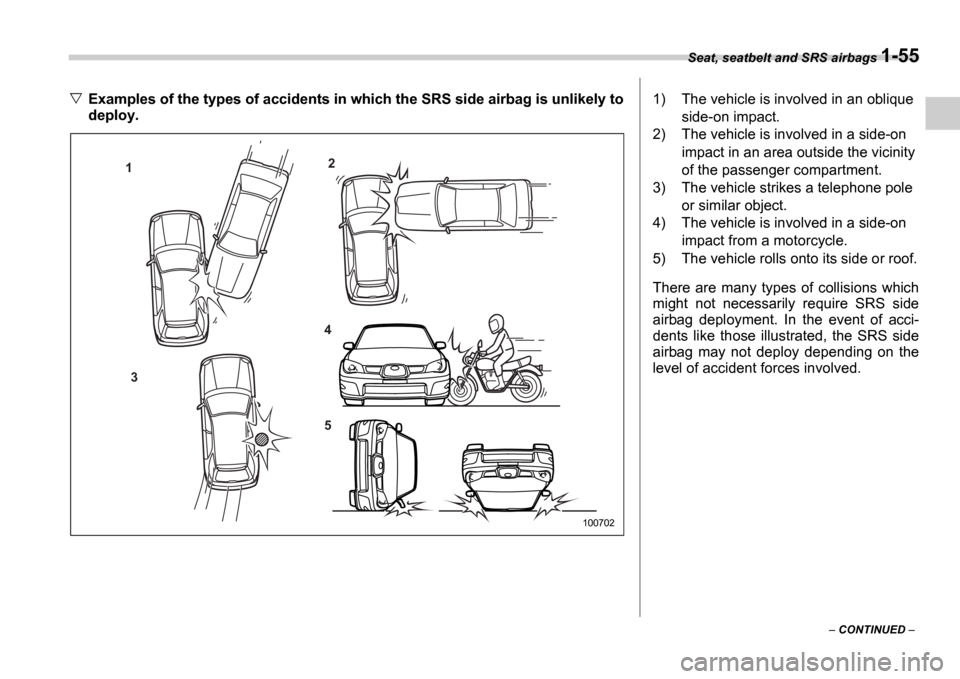
Seat, seatbelt and SRS airbags 1-55
CONTINUED
Examples of the types of accidents in which the SRS side airbag is unlikely to
deploy.
1 2
3 4 5
100702
1) The vehicle is involved in an oblique
side-on impact.
2) The vehicle is involved in a side-on
impact in an area outside the vicinity
of the passenger compartment.
3) The vehicle strikes a telephone pole or similar object.
4) The vehicle is involved in a side-on impact from a motorcycle.
5) The vehicle rolls onto its side or roof.
There are many types of collisions which
might not necessarily require SRS side
airbag deployment. In the event of acci-
dents like those illustrated, the SRS side
airbag may not deploy depending on the
level of accident forces involved.
Page 83 of 365

1-56 Seat, seatbelt and SRS airbags
Examples of the types of accidents
in which the SRS side airbag will ba-
sically not deploy.
1) The vehicle is involved in a frontal colli-
sion with another vehicle (moving or sta-
tionary).
2) The vehicle is struck from behind.
The SRS side airbag is basically not de-
signed to deploy if the vehicle is involved
in a frontal collision or is struck from be-
hind. Examples of such accidents are il-
lustrated.
1) First impact
2) Second impact
In an accident where the vehicle is struck
from the side more than once, the SRS
side airbag deploys only once on the first
impact.
Example: In the case of a double side im-
pact collision, first with one vehicle and
immediately followed by another from the
same direction, once the SRS side airbag
is activated on the first impact, it will not be
activated on the second.
SRS airbag system monitors
A diagnostic system continually monitors
the readiness of the SRS airbag system
(including front seatbelt pretensioners)
while the vehicle is being driven. The SRS
airbag system warning light AIRBAG will
show normal system operation by lighting
for approximately 6 seconds when the ig-
nition switch is turned to the ON position.
The following components are monitored
by the indicator:
Front sub sensor (Right-hand side)
Front sub sensor (Left-hand side)
Airbag control module (including impact
sensors)
Frontal airbag module (Driver s side)
Frontal airbag module (Front passen-
ger s side)
1 2
100703
2
1
100629
100291
Page 84 of 365
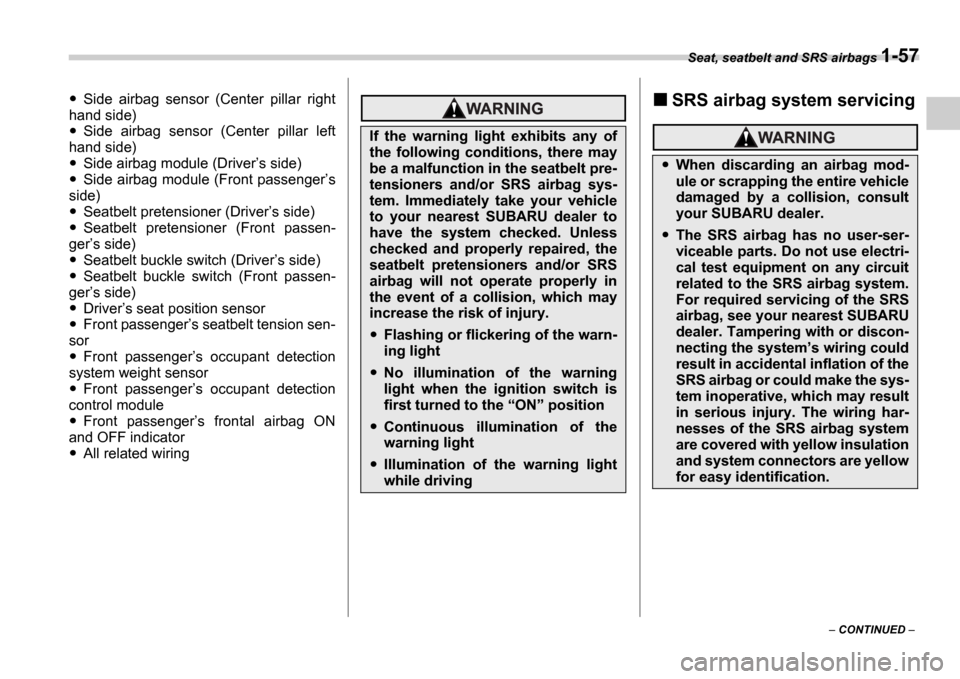
Seat, seatbelt and SRS airbags 1-57
CONTINUED
Side airbag sensor (Center pillar right
hand side)
Side airbag sensor (Center pillar left
hand side)
Side airbag module (Driver s side)
Side airbag module (Front passenger s
side)
Seatbelt pretensioner (Driver s side)
Seatbelt pretensioner (Front passen-
ger s side)
Seatbelt buckle switch (Driver s side)
Seatbelt buckle switch (Front passen-
ger s side)
Driver s seat position sensor
Front passenger s seatbelt tension sen-
sor
Front passenger s occupant detection
system weight sensor
Front passenger s occupant detection
control module
Front passenger s frontal airbag ON
and OFF indicator
All related wiring
SRS airbag system servicing
If the warning light exhibits any of
the following conditions, there may
be a malfunction in the seatbelt pre-
tensioners and/or SRS airbag sys-
tem. Immediately take your vehicle
to your nearest SUBARU dealer to
have the system checked. Unless
checked and properly repaired, the
seatbelt pretensioners and/or SRS
airbag will not operate properly in
the event of a collision, which may
increase the risk of injury.
Flashing or flickering of the warn-
ing light
No illumination of the warning
light when the ignition switch is
first turned to the ON position
Continuous illumination of the
warning light
Illumination of the warning light
while driving
When discarding an airbag mod-
ule or scrapping the entire vehicle
damaged by a collision, consult
your SUBARU dealer.
The SRS airbag has no user-ser-
viceable parts. Do not use electri-
cal test equipment on any circuit
related to the SRS airbag system.
For required servicing of the SRS
airbag, see your nearest SUBARU
dealer. Tampering with or discon-
necting the system s wiring could
result in accidental inflation of the
SRS airbag or could make the sys-
tem inoperative, which may result
in serious injury. The wiring har-
nesses of the SRS airbag system
are covered with yellow insulation
and system connectors are yellow
for easy identification.